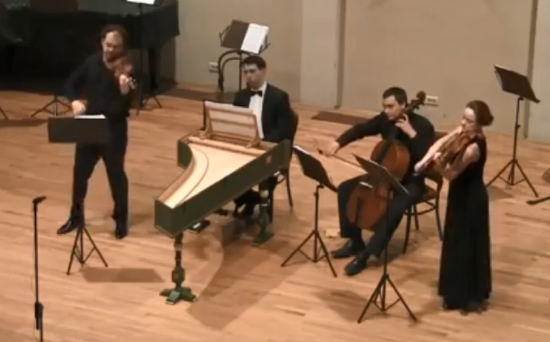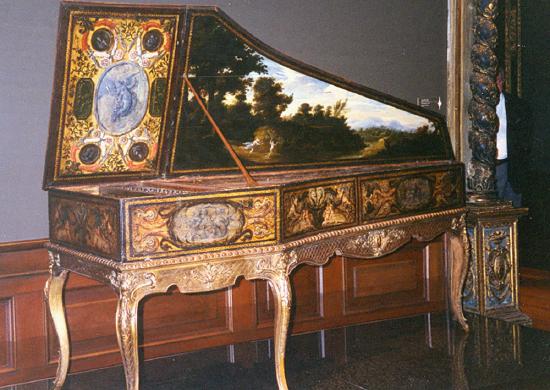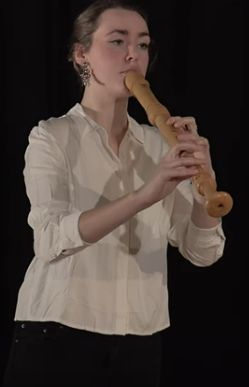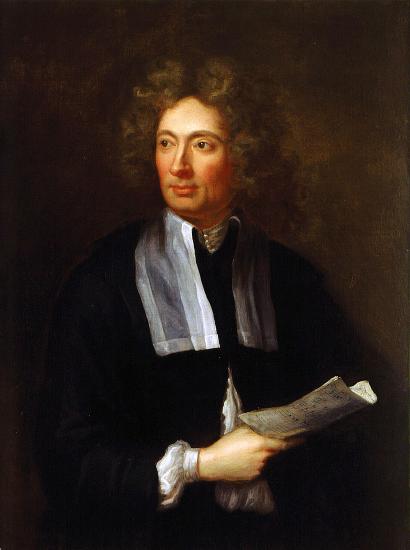5.2: Chamber Music in the Baroque Period (1600-1750)
- Page ID
- 165597
Chamber Music in the Baroque Era (1600-1750).

Croatian Baroque Ensemble. Screenshot taken from YouTube. The harpsichord player is the 2nd from left.
Recall that the Baroque Period begins what we call the Common Practice Era. It is with the Baroque Period where music begins to sound more like modern-day music; music from the time periods that preceded the Baroque Period sound very different than our modern-day music. Readers should re-familiarize themselves with the chapter that briefly addresses musical time periods before moving on. After reading this page, readers should view the Video Presentation that discusses these concepts in more detail.
Popular Baroque Instruments.
The Harpsichord

"Ringling Museum - Harpsichord" by roger4336 is licensed under CC BY-SA 2.0.
Music in the Baroque Era almost always included a harpsichord player. The harpsichord is a keyboard instrument, similar to the piano, but is very delicate (you'll hear how delicate it is in the video presentation). The harpsichord was a crucial member of the ensemble, and the keyboard player was required to provide the lowest notes with the left hand, while often improvising with their right hand, using chords that the composer instructed them to play. Even a piece of music that was written for a "solo" instrument often included the harpsichord. As you can see from the above picture, the physical appearance was just as important as the music it played! These instruments often had beautiful woodwork inlays around the instrument, and the lid was often painted with a beautiful mural. Take a listen to Elaine Comparone performing a solo harpsichord piece by Jean-Philippe Rameau called "Les Cyclopes."
Baroque Recorder.

Clara Guldberg performs on the Baroque recorder. Screenshot taken from YouTube.
One instrument that was very popular in the Baroque Period (and its preceding time periods) was the recorder. The Baroque recorder was typically made of wood, and it was similar to the flute, in that it had no reeds. It has a very airy and almost "breathy" sound when played. There are many sizes of the recorder: the soprano, alto, tenor, and bass recorder---this allowed for composers to write music for a "Recorder Ensemble," which similar to the String Quartet, combined four different sizes of the same type of sound. Take a listen to the Flanders Recorder Quartet performing Merula's "Canzona La Lusignuola" for four recorders, and you'll see what type of sound one can get with this type of instrumental group.
The recorder fell out of favor at the beginning of the Classical Era (1750-~1820). If you find yourself listening to music on the radio and you hear a recorder, it is very likely that the music was written during the Baroque Period!
Popular Types of Chamber Music in the Baroque Period.
The most common types of chamber music of the Baroque Period consisted of the Trio Sonata and the Instrumental Sonata. In these instances, the term "sonata" simply means "instrumental" music, as opposed to "vocal" or "sung" music. (Remember that it wasn't until the Classical Era (1750-~1820) where composers began to use the term "sonata" to refer to a single movement's form). Trio Sonatas and Instrumental Sonatas both contained several movements of music, and unlike the Classical Period's Symphony and String Quartet, which almost always had 4 movements, Trio Sonatas and Instrumental Sonatas often did not have a specific amount of movements that were expected. Some had 4 movements, some had 5 movements, others might only have 3.
Trio Sonatas actually have four instruments! This is because it is a "trio" of performers with an added harpsichord player! In other words, the harpsichord player was such a staple in chamber ensembles, that they didn't even feel that they needed to include it in the ensemble's name because it was expected that the group would have one!
Instrumental Sonatas often had 2 instruments: the soloist, and the harpsichord player. Sonatas that didn't have a harpsichord player accompanying them would often be called "unaccompanied instrumental sonatas." In other words, they needed to let the performer/audience know that the harpsichord player wasn't there---again, because its presence was always expected!
Many composers wrote for smaller ensembles, which as mentioned above, almost always included a harpsichord player. The video presentation covers extensively both a Trio Sonata and an Instrumental Sonata by two of the most well-known composers of the time period: Arcangelo Corelli and JS Bach.
Baroque Composers Covered in this Unit.

Arcangelo Corelli (1653-1713)
Arcangelo Corelli (1653-1713) was a well-known Italian musician in the Baroque period. He was proficient as a violinist, composer, and was a highly respective teacher in his tim period. He was very important in the development of instrumental music, especially as it pertains to the Instrumental Sonata and the Instrumental Concerto (concertos are pieces for a solo performer accompanied by a full orchestra; you'll learn more of the concerto in Chapter 8).
He composed 48 trio sonatas, 12 violin sonatas, and 12 concerto grossi (these are concertos for a small group of soloists with a full orchestra accompanying them). Though the Corelli is not as well-known as some of his contemporary composers like J.S. Bach, Vivaldi, or G. F. Handel (outside of music scholars, that is), his influence on instrumental chamber music cannot be understated. The video presentation will address one of his Trio Sonatas in D minor that contains 5 movements.
Portrait of Arcangelo Corelli by Hugh Howard. Public Domain.

Johann Sebastian Bach (1685-1750)
Arguably the most well-known composer of the Baroque period, Johann Sebastian Bach was born in Germany in 1685. He composed over 1000 pieces of music. This alone is an impressive number, but it's also important to remember that many of this pieces contained multiple movements, and might last over 2 hours! The man had many different jobs as a musician between the ages of 18-38, and depending on his job, he often composed different works. For instance, while working as a church organist in Weimar, he composed dozens of works for solo organ. While working as a concertmaster Weimar, he composed orchestral music, and while working as a cantor at St. Thomas' Church in Leipzig, he composed many of his cantatas, which combined choir, solo singers, and orchestra. He was married twice, and between he and his two wives, he fathered 20 children, several of whom became well-known composes in their own right, including J.C. Bach, and C.P.E Bach. Toward the end of his life, the Baroque Style began to fall out of favor due to the rising popularity of the early Classical style. We mark the end of the Baroque Era (1750) with his death, which coincides with what we refer to as the beginning of the "High" Classical Era that the previous chapter discussed.
Throughout this text, we'll hear a few pieces by J.S. Bach, especially when we cover the Organ in the chapter on Keyboard Music. This chapter covers one of his sonatas for solo recorder. The recording you'll watch consists of 3 musicians: a solo recorder, a cello, and a harpsichord.
Famous portrait of J.S. Bach by Elias Gottlob Haussmann. Public Domain.

